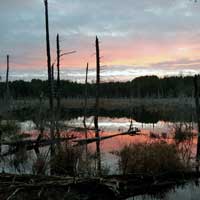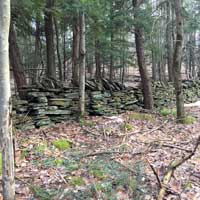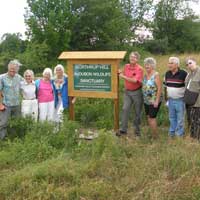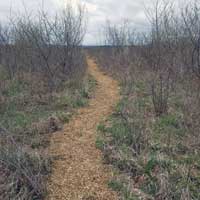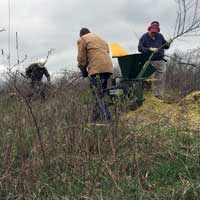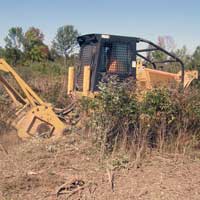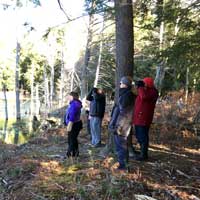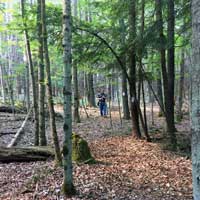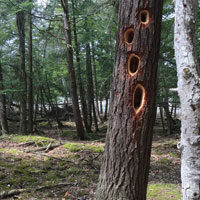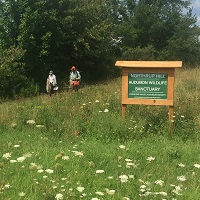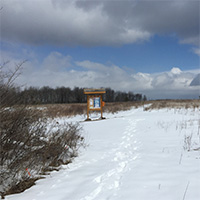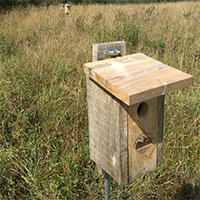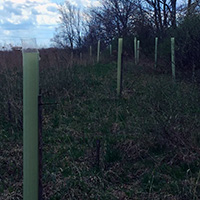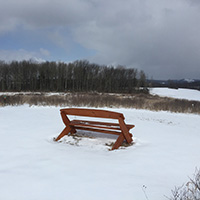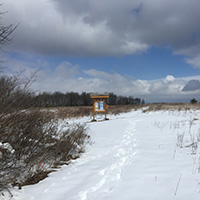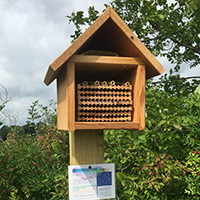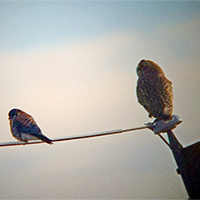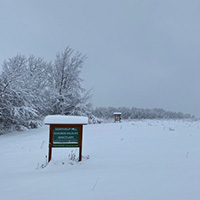
Northrup Hill Audubon Wildlife Sanctuary
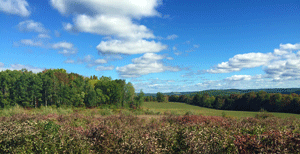
The Northrup Hill Wildlife Sanctuary is a diverse 24-acre wildlife preserve in the Town of Rathbone, Steuben County, New York. The land was acquired as a gift from the Northrup family to be used as a nature preserve and is located behind the Northrup Hill Schoolhouse, a building on the USDI National Historical Register. This sanctuary has a diversity of habitats including grasslands, early successional hardwoods, and white pine-hemlock- hardwood forest leading down to a wetland-marsh at the north end. The elevation of this sanctuary is 1700 feet with nice views of the surrounding country side with benches for visitors to enjoy the view. The soils are alluvial in the Arnot, Chippewa, Lordstown and Mardin soils series. Trails are open to the public during daylight hours.
Audubon protects valuable habitats and the birds that depend on them: Important Bird Areas (IBA). Find IBAs in our area at Audubon.org.
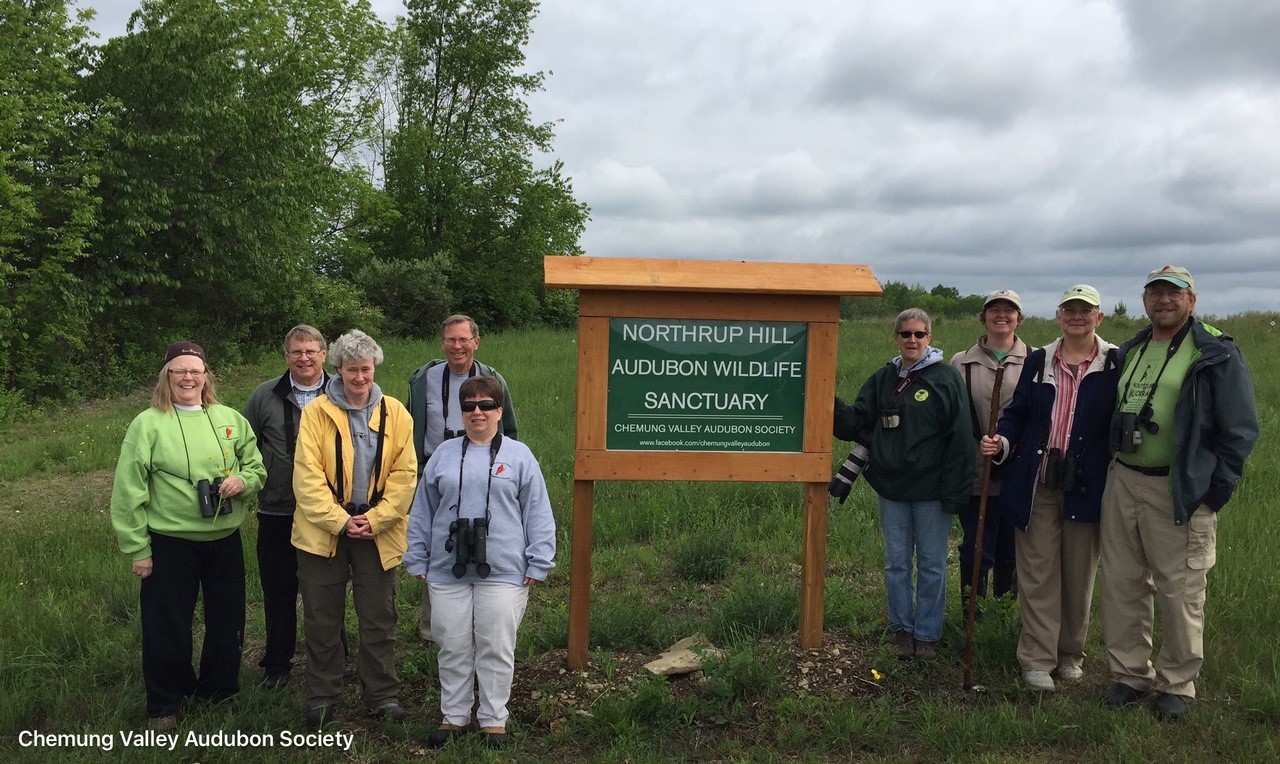
Location
Learn Road, Rathbone, New York | Approximately 40 minute drive from Corning, New York. Maps of this location can be viewed here and here.
Directions
From Corning, take Route I86 to exit 44A for Route 15 (I99) South. Follow Route 15 South to exit 8 for Route 417-Addison. Turn right off the ramp and follow Route 417 to Addison. In Addison, turn right onto CR 119 (by Wades Hardware Store). Continue on 417 to Rathbone and turn left onto CR 21 (by Rathbone Town Hall-Highway Department). Go a short distance going over a creek and turn right onto CR 80. Route 80 curves slightly to the left and then continues on for one mile to Learn Road. Turn left onto Learn Road and proceed two miles. You will pass the Northrup Hill Schoolhouse and the wildlife sanctuary entrance is 200 feet beyond on the right by the sign. Please park on the side of the road.
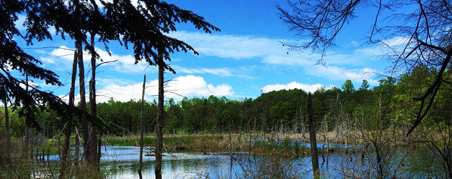
From Corning, take Denison Parkway West and NY 417 to the I-99 in Gang Mills Follow I-99 to Addison, about ten miles. Leave Addison on CR 119. Turn left into and through Rathbone. After crossing the bridge, turn left on to Tracy Creek Road and head up the hill about a mile, turn left on Learn Road and there is a historic one-room school house at the intersection at the top of the hill. Total about 8.5 miles from Addison. The sanctuary is located behind the school house.
Trails
Trails are open for public use for hiking, birding, and cross country skiing. Hunting, trapping, and motorized vehicles are prohibited.
The trails are mowed through the grasslands, and in the forest, follow the white trail marks on the trees.
From the entrance, take the main trail through the grassland to the summit, where you will find a bench to enjoy the vista of the surrounding country side. Continue on the trail to the woods, go straight and the trail comes out to the second grassland. At this point, follow the trail to the right, proceeding across to the white pine-hardwood forest. The trail goes along the east borderline of the property. Turn left as you approach the north border into a hemlock forest. Continue going downhill and you will reach a beautiful marsh (if you proceed quietly, you may not scare off the waterfowl). From the marsh, follow the trail back up the hill which will bring you out into grassland. Cross the grassland and you will intersect back to where you branched off.
There are a few side loop trails off the main trail that can also be explored.
A Winter Walk through Northrup by Mary Jane Dugan
It is a cold, 23-degree morning on February 10, 2019, but the sun is shining in the clear blue sky, so my husband, Brian, and I decide to explore Northrup Hill Audubon Wildlife Sanctuary in Rathbone, NY. We arrive an hour before noon.
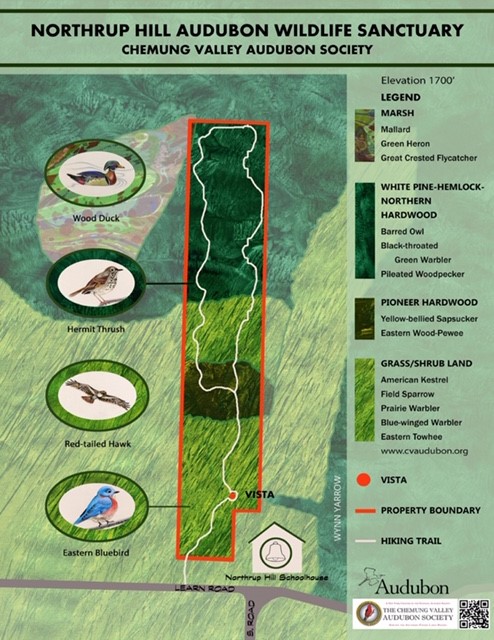
There is a large field across the road from Northrup that used to host Eastern Meadowlarks. Several years ago, the owner gave growing soy beans a go for a season, and the Meadowlarks never returned. The hawks like the field, though. South Road, which borders the field, had a Northern Harrier on one powerline post and a Red-Tailed Hawk on the next.
As we pull to the side of road next to Northrup, we see a second Harrier. A breeding pair perhaps?
Stepping out of the car, we are aware of the silence. All we can hear is the wind. A calm and peaceful feeling overcomes us. We stop to sign the book housed at the kiosk. The last three visitors were the same person: Don Hall.
Our trek takes us from the beginning to the end of the long, narrow property. For those who have not had the privilege to explore this wilderness, you should know that it is quite diverse in habitat. The first segment is a shrubby field. As we walk, we note that trees planted in prior years appeared to be doing well. We discuss removing invasive plants and replacing them with native plants as we move through the field.
At the end of the field is a stand of trees. It spans from property line to property line, so you can’t go around it; you must go through it. We see evidence of Mother Nature pruning back dead trees and branches. There is some trail work to be done here.
At the end of the treed area, we walk out to a field that is mostly grasses. We see mounds of grass heaped up in a manner that resembles an upside-down teacup. Neither Brian nor I have seen anything like this before: ant mounds. The mounds dot this field. We check to see how the cedar trees that we planted last spring have fared. Most are doing well, except a few browsed almost to the ground. Not much work to do here: put wire around surviving cedars; and perhaps, replace those that did not survive.
We enter a second stand of trees, a different environment than the first. It is darker, has more trees with massive trunks—it is a bit eerie, to tell the truth. Again, there is a feeling of peace and tranquility that only nature can gift us. We look around and observe that the woods have been anything but tranquil. Fallen trees again demonstrate nature’s power.
We continue downhill, towards the trail and property’s end: a pond that I do not believe has been named. Green mosses dot the undulating forest floor, and everywhere, we see evidence of an active beaver colony. For a third time, we are overcome by that sense of peace and tranquility. The pond is shielded with ice. We can hear it popping, cracking. The bench placed near the shore is now surrounded by water, an island. A new beaver lodge is next to the shoreline near our trail.
We don’t count the trees downed or girdled by the beavers; there are many. Though we did not see any beavers, the evidence suggests their family is growing. As we circle back, Brian speaks of a natural opening in the canopy and how this space could be opened more, and new plantings could come in. It is all about creating a habitat for birds and other animals.
On our way home we mention more than once how enjoyable the trip was—not too many birds today, but still so much to embrace in this world that is good.
Tree Plantings at Northrup
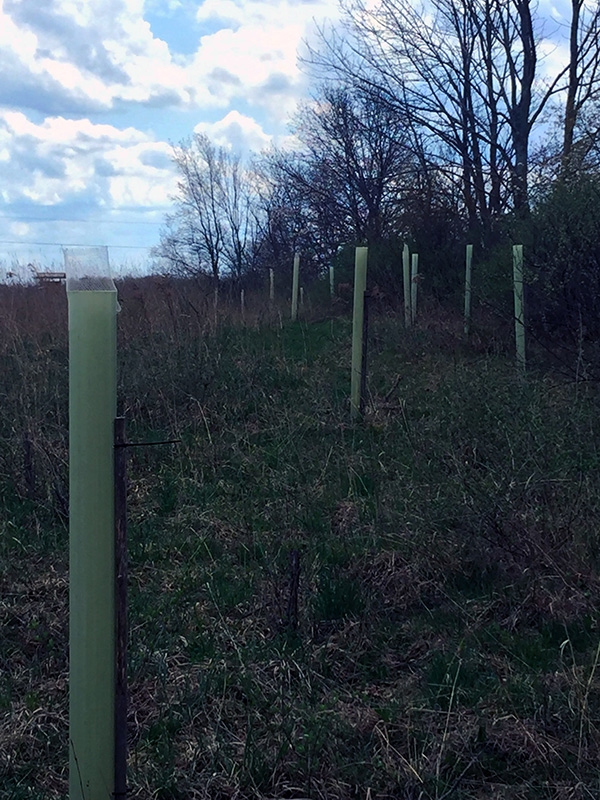
Two types of planting styles are currently used for trees at Northrup Hill Audubon Wildlife Sanctuary: boundary planting and group planting. Boundary planting consists of trees which are planted in a straight line, giving definition to the property by providing a visual separation between one property and another or a transitional area between grassland/shrub land and woodlot. This transitional zone provides habitat for all wildlife.
The margin of the northern field is a boundary planting with 20 Northern White Cedar, Thuja accidentalis, used for property definition in the upper field and a wind break.
A boundary planting was used along the walking path in the first woodlot consisting of ten Paper (or White) Birch, Betula papyrifera, to add definition to the path. Along this path, notice fungi growing on stumps.
You will notice the second type of planting in the first woodlot. Sugar (or Hard) Maple, Acer saccharum, were planted using the group planting method. This experimental planting, which includes ten Sugar Maples, is copying Mother Nature’s dispersal method. When Sugar Maples disperse their seeds, they appear to helicopter and land in a circular pattern adjacent the parent tree. There are few Sugar Maples in this woodlot; accordingly, this experiment is meant to augment their numbers. In the following years, more Sugar Maples are planned to be group planted.
Saplings are a favorite food for deer so most tree plantings are protected with a 5 foot tubular sleeve. Trees, protective tubes and stakes were donated for this project by Chemung County Soil and Water and by CVAS chapter member.
Thank you to Brian Dugan for providing this overview of tree planting.
Native Plants
Beginning in 2022, in a prepared 20-square-foot space, Chemung Valley Audubon members Brian and Mary Jane Dugan began planting Andropogon gerardi (big bluestem) and Sporobolus heterolepis (prairie dropseed), both native grasses; and Coreopsis lanceolata (lanceleaf coreopsis).
Brian and Mary Jane have since made an extensive expansion to the native plant and pollinator garden, incorporating a wide variety of native flowering plants and grasses.
This section provides information about the wide range of plants that were planted in the Fall of 2022 or are currently being grown to be transplanted into the gardens in the months ahead or in Spring 2024, depending on how successfully they are rooted.
We invite you to visit the site and enjoy the progress and growth of the garden in 2023.
Pollinator Plants for Northrup
 Swamp (Rose) Milkweed |
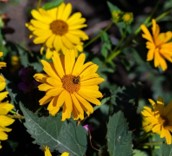 Early Sunflower |
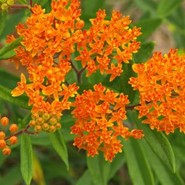 Butterfly Weed |
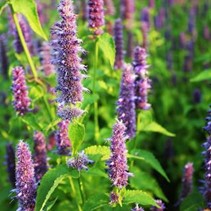 Anise Hyssop |
"Swamp (a.k.a. rose) milkweed is an exceptional plant for pollinators, attracting Hawk moths, Swallowtail butterflies, Fritillaries, Monarchs, skippers, bumble bees and numerous other nectar seekers - even an occasional hummingbird." [Source: Bagley Pond Perennials]
"Butterfly Weed and Early Sunflower are both butterfly magnets. The leaves are the preferred food source for the caterpillar of several species of butterflies, including monarchs. The flowers provide nectar for both butterflies and hummingbirds." [Source: Walton Outdoors]
"Anise Hyssop, like many other members of the mint family, is a bee magnet. The flowers are highly attractive to honey bees and many of our native bees such as bumble bees, mining bees, leaf cutter bees, and sweat bees. Butterflies, moths, and hummingbirds will also frequently visit the flowers." [Source: Backyard Ecology]
"New England Aster attracts bees including Andrenid bees, sweat bees, small carpenter bees, and bumble bees. Expect hordes of bees, butterflies, beetles, and moths sipping the nectar in the fall. Rabbits seem not to like to eat most species in this genus." [Source: Donna Long] "The New York Aster provides pollen for insects during its late blooming season, which helps bees when few other plants are flowering. The Aster looks beautiful and attracts butterflies, moths and bees, contributing beauty, diversity and very efficient pollination activity." [Source: Greenfield Community College]
"Purple Coneflower is highly attractive to a wide range of bees including honey bees, native bees, and leafcutter bees, who collect nectar and pollen from purple coneflowers. Many different species of butterflies including monarchs, tiger swallowtails, skippers, American ladies, red admirals, and fritillaries will also feed on the nectar." [Source: Backyard Ecology]
"White false/wild indigo attracts and hosts numerous insects. Bumblebees are attracted to and are primary pollinators of the flowers. The foliage of white false indigo often hosts a large number of caterpillars, including the wild indigo duskywing and orange sulfur caterpillars." [Source: Lurie Garden]
"Foxglove Beardtongue primarily attracts long-tongued bees such as honeybees, bumblebees, Mason, Leaf-cutter, and Miner Bees. It can also attract various butterflies, sphinx moths, and hummingbirds, but you will mainly see bees on the flowers. A pollinator favorite, this is one of the first plants to start drawing in bees after the flowers of the trees have bloomed." [Source: GrowItBuildIt]
"Big Bluestem (grass) attracts hummingbirds and a large number of native bees [because it's a] source of nectar... Little Bluestem attracts birds, and butterflies and is a larval host for the Ottoe skipper, Indian skipper, Crossline skipper, Dusted skipper, Cobweb butterfly, and Dixie skipper... Virginia Rye is a butterfly/moth host and a source of food for birds and small animals... Along with little bluestem, big bluestem and switchgrass, Indian grass is an important species in the tallgrass prairie. The bright yellow flowers contrast attractively with the blue-gray foliage. The grass stays low most of the year and then gets tall before blooming in early autumn. Like little bluestem, Indian grass is best planted en masse or in a wildflower meadow... Switchgrass [provided in amounts to demonstrate its appearance for interested parties] is a clump-forming, warm-season grass with open, lacy sprays with small seeds and purple stigmas at flowering time. Switchgrass is a 3-6 ft., rhizomatous, loose sod former with a large, open, finely textured, reddish-purple seedhead. Fall color is pale yellow. Bright green leaves occur up and down the stem, turning bright yellow in fall. Switchgrass is a perennial that grows in large clumps, with many persistent, curly leaves. Switchgrass is one of the dominant species of the tallgrass prairie, but also grows along roadsides where moisture is present. The rich, yellow-colored clumps last throughout the winter." [Source: Wildflower.org]
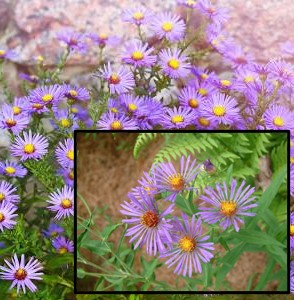 New England Aster and [inset] New York Aster |
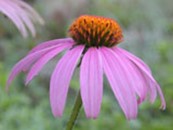 Purple Coneflower |
 White Wild Indigo |
 Foxglove Beardtongue |
Google Map for The Northrup Hill Audubon Wildlife Sanctuary
More Images of the Sanctuary
Click on a thumbnail to view a larger version in a new window.
Birds Recorded at the Sanctuary
For a description of each of these birds, please visit the Audubon Field Guide.
| American Crow | American Goldfinch | American Robin |
| Barred Owl | Belted Kingfisher | Blackburnian Warbler |
| Black-Capped Chickadee | Blackpoll Warbler | Black-Throated Blue Warbler |
| Black-Throated Green Warbler | Blue Jay | Blue-Headed Vireo |
| Blue-Winged Warbler | Boblink | Brown Creeper |
| Brown-Headed Cowbird | Canada Goose | Chipping Sparrow |
| Common Grackle | Common Raven | Common Yellowthroat |
| Dark-Eyed Junco | Downy Woodpecker | Eastern Phoebe |
| Eastern Screech-Owl | Eastern Towhee | Eastern Wood Pewee |
| Field Sparrow | Golden-Crowned Kinglet | Gray Catbird |
| Great Blue Heron | Great Crested Flycatcher | Great Horned Owl |
| Hairy Woodpecker | Hermit Thrush | House Finch |
| House Wren | Indigo Bunting | Killdeer |
| Least Flycatcher | Mongolia Warbler | Mourning Dove |
| Northern Cardinal | Northern Flicker | Northern Parula |
| Northern Saw-Whet Owl | Ovenbird | Philadelphia Vireo |
| Pileated Woodpecker | Prairie Warbler | Purple Finch |
| Red-Breasted Nuthatch | Red-Eyed Vireo | Red-Winged Blackbird |
| Rose-Breasted Grosbeak | Ruby-Crowned Kinglet | Ruffed Grouse |
| Scarlet Tanager | Solitary Sandpiper | Song Sparrow |
| Tufted Titmouse | Veery | White-Breasted Nuthatch |
| White-Throated Sparrow | Wild Turkey | Wilson’s Warbler |
| Wood Duck | Wood Thrush | Yellow-Bellied Sapsucker |
| Yellow-Rumped Warbler |
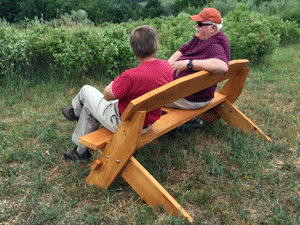
Plants Recorded at the Sanctuary
The following list of plants recorded at the sanctuary was compiled by Alex Petzke. You can download this list by clicking here.
| Taxonomic Name | Common Name | Native (N) or Exotic/Introduced (E) |
|---|---|---|
| Acer rubrum | Red Maple | N |
| Anthoxanthum odoratum | Sweet Vernal Grass | E |
| Arisaema triphyllum | Jack-in-the-Pulpit | N |
| Asclepias syriaca | Common Milkweed | N |
| Brachyelytrum aristosum | Erect Woodland Grass | N |
| Carex folliculata | Long Sedge | N |
| Carex scoparia | Broom Sedge | N |
| Carpinus caroliniana | Musclewood | N |
| Clinopodium vulgare | Wild Basil | N |
| Cornus sp. | Dogwood | N |
| Dactylis glomerata | Orchard Grass | E |
| Dryopteris carthusiana | Spinulose Wood Fern | N |
| Elaeagnus umbellata | Autumn Olive | E |
| Epipactis helleborine | Hellebore | E |
| Eurybia divaricata | White Wood Aster | N |
| Fagus grandifolia | American Beech | N |
| Fragaria vesca | Strawberry | N |
| Fraxinus americana | White Ash | N |
| Galium album | Bedstraw | E |
| Geum laciniatum | Rough Avens | N |
| Hypericum perforatum | Common St. John's Wort | E |
| Impatiens sp. | Jewelweed | N |
| Lemna sp. | Duckweed | N |
| Leucanthemum vulgare | Ox-Eye Daisy | E |
| Leucobryum glaucum | Cushion Moss | N |
| Lonicera morrowi | Honeysuckle | E |
| Lotus corniculatus | Bird's-Foot Trefoil | E |
| Lysimachia borealis | Starflower | N |
| Maianthemum canadense | Cananda Mayflower | N |
| Onoclea sensibilis | Sensitive Fern | N |
| Osmunda claytoniana | Interrupted Fern | N |
| Ostrya virginiana | Eastern Hophornbeam | N |
| Parthenocissus quinquefolia | Virginia Creeper | N |
| Penstemon digitalis | Eastern Beardtongue | N |
| Phalaris arundinacea | Reed Canary Grass | N |
| Phleum pratense | Timothy | E |
| Pinus strobus | Eastern White Pine | N |
| Plantago lanceolata | Lance-Leaved Plantain | E |
| Polystichum acrostichoides | Christmas Fern | N |
| Prenanthes sp. | Rattlesnake Root | N |
| Prunus serotina | Black Cherry | N |
| Pteridium aquilinum | Bracken Fern | N |
| Ranunculus acris | Common Buttercup | E |
| Rhamnus cathartica | Buckthorn | E |
| Rubus allegheniensis | Blackberry | N |
| Rudbeckia hirta | Black-Eyed Susan | N |
| Rumex crispus | Curly Dock | E |
| Thelypteris noveboracensis | New York Fern | N |
| Trifolium pratense | Red Clover | N |
| Tsuga canadensis | Eastern Hemlock | N |
Planting Styles

Two types of planting styles are currently used for trees at Northrup Hill Audubon Wildlife Sanctuary: boundary planting and group planting. Boundary planting consists of trees which are planted in a straight line, giving definition to the property by providing a visual separation between one property and another or a transitional area between grassland/shrub land and woodlot. This transitional zone provides habitat for all wildlife.
The margin of the northern field is a boundary planting with 20 Northern White Cedar, Thuja accidentalis, used for property definition in the upper field and a wind break.
A boundary planting was used along the walking path in the first woodlot consisting of ten Paper (or White) Birch, Betula papyrifera, to add definition to the path. Along this path, notice fungi growing on stumps.
You will notice the second type of planting in the first woodlot. Sugar (or Hard) Maple, Acer saccharum, were planted using the group planting method. This experimental planting, which includes ten Sugar Maples, is copying Mother Nature's dispersal method. When Sugar Maples disperse their seeds, they appear to helicopter and land in a circular pattern adjacent the parent tree. There are few Sugar Maples in this woodlot; accordingly, this experiment is meant to augment their numbers. In the following years, more Sugar Maples are planned to be group planted.
Saplings are a favorite food for deer so most tree plantings are protected with a 5 foot tubular sleeve. Trees, protective tubes and stakes were donated for this project by Chemung County Soil and Water and by CVAS chapter member.
Thank you to Brian Dugan for providing this overview of tree planting.
